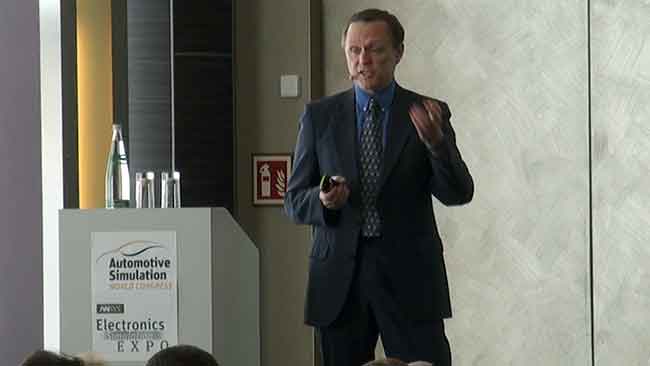
Good automotive simulation is already hard, and it is getting harder. Ansys sees automotive simulation growth through the electrification of cars and developments in autonomous vehicles.
Simulation is a $1 billion market in the automotive segment. When the market leader has approximately 12% market-share, you understand that there are many players in the market and tremendous business potential for a sharp competitor. What does that mean to Ansys?
First, it means being big. Big in capabilities. The automotive market segment for simulation has an extremely wide range of difficult simulation problems to address.
Ansys : four pillars for a competitive strategy

First, this includes having the best technology in their solvers. Simulation solvers are the core software used for any simulation problem. The technology used to solve the hardest, most challenging simulation problems is constantly changing. Therefore, technology leadership in CAE means having the best technology in your solvers. This challenge is essential for Ansys because the simulation market has many competitors which are often highly specialized in a single niche domain of simulation.
Second, Ansys relies on its strategic ability to take the large variety of simulation problems related to a single product and provide the ability to completely test a virtual prototype. Using a vehicle system such as a brake assembly, Ansys technology allows customers to test the brake for structural stress, fluid simulations, thermal analysis, electro-magnetic simulation, etc. This virtual-prototype simulation ability provides a competitive advantage over smaller, more specialized competitors.
Third, Ansys invests in technologies and solutions for process-compression. This is to allow clients to simulate faster, more efficiently, and, when desired, to perform more simulation in order to improve their products and shorten development cycles. These technologies range from wizards and programming interfaces to support faster and customized workflows so that customers can accelerate their simulation work. It also includes high-performance computing (HPC). Ansys leads in many areas of HPC-based simulation. CFD simulations have been run on over 100,000 computing cores with a greater than 90% efficiency. Since many of the most difficult simulation problems can be solved using HPC systems, the ability that Ansys offers to run on large-scale HPC systems allows clients to run simulations faster.
Fourth, Ansys focuses on providing dynamic collaboration for its customers. Many clients have very diverse, distributed project teams. Ansys makes it a point to develop and deliver tools which support more and easier team collaboration.
Industry and Macro-trends are driving business
The automotive industry finds itself in the cross-hairs of several technology shifts. One is the drive towards more efficient and electric vehicles. Another is the development of autonomous vehicles. Yet another is the smart, connected nature of cars in the Internet of Things (IoT). These macro-trends influence the increased demand for simulation in the automotive sector, while traditional demands in vehicle simulation continue to gain general acceptance.
An overview of industry trends increasing the use of simulation in the automotive sector:
- Broader awareness and acceptance of simulation.
- After 30 years, CAE is still not used by all companies, yet automotive OEMs are now accepting simulation results for product verification in lieu of physical prototypes.
- Autonomous driving
- autonomous vehicles have literally billions of test-case permutations
- thorough physical, road-testing would require 100 years of tests, therefore,
- validation of self-driving vehicles creates an exploding requirement for simulation
- Internet of Things (IoT)
- cars are now smart, connected and able to integrate into smart-cities.
- sub-systems in vehicles are also smart & connected and part of the IoT
- the addition of many smart components and antennas increase demands for mechanical, RF, thermal, and software simulation
- Electrification of vehicles
- electric power-trains demand more simulation
- electronics, entertainment systems, electronic dashboards, sensors, all impose new simulation requirements
Ansys wins when the company stays ahead of the game
The strategy of anticipating simulation needs in the industry and building a solution to attack that need has served the company well in the past - for example with the introduction of electric drive trains - and this is the strategy driving Ansys developments today. The firm is delivering solutions for autonomous vehicle simulation and validation as well as a complete simulation package addressing IoT developments. By building these solutions just before clients need them, Ansys attempts to play a key technology supplier role as each wave of change rolls over the automotive industry.
The PW perspective
The economic trends have been difficult for many technology companies. Ansys financial reports over the last two years reflect that. However, the company can deliver a broader range of simulation solutions than most competitors. If the company maintains leadership in the simulation technologies, combines those technologies to deliver full virtual-prototype simulations, compresses the time required for simulation, and allows dispersed, global teams to collaborate effectively, then the company will be fulfilling its strategic goals, it will be able to capitalize on the macro-developments of autonomous driving and IoT, and Ansys will continue to be one of the most, relevant simulation technology providers to the automotive industry.
Take about 10 minutes to hear directly from Sandeep Sovani about the Ansys business, strategy, and solutions for the automotive sector





